Spyker D12 Peking-to-Paris
Geneva, Switzerland, 28 February 2006: His Excellency Khaldoon Khalifa Al Mubarak, CEO Mubadala Development Company and Victor Muller, CEO Spyker Cars, today unveiled the Spyker D12 Peking-to-Paris at the 76th Salon International de l’Auto in Geneva.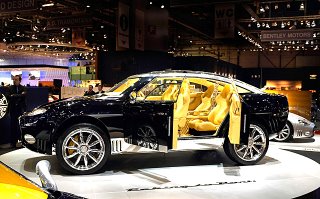
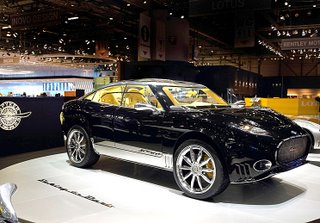
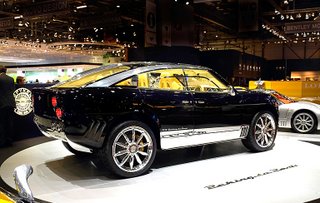
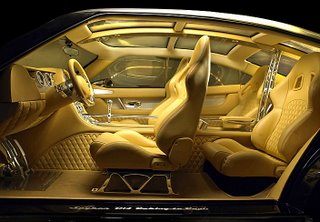
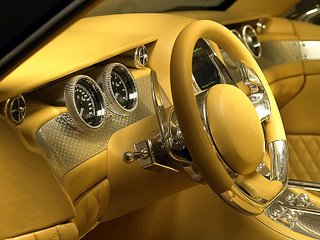 The world premiere of this Super Sports Utility Vehicle (SSUV) marks the introduction of a second product line for Spyker who are already known for producing the Spyker C8 Spyder, Laviolette and Double12 and C12 LaTurbie super sports cars. The Spyker D12 Peking-to-Paris is a four-wheel drive, four-door, four-seater luxury Super Sports Utility Vehicle with a spacious interior and a high performance W12 500 bhp engine. Production is due to start in the fourth quarter of 2007. This is the fourth time that the Dutch manufacturer of exclusive high quality hand-built sports cars and now SSUVs is present at the Geneva Motor Show since 2000.
The world premiere of this Super Sports Utility Vehicle (SSUV) marks the introduction of a second product line for Spyker who are already known for producing the Spyker C8 Spyder, Laviolette and Double12 and C12 LaTurbie super sports cars. The Spyker D12 Peking-to-Paris is a four-wheel drive, four-door, four-seater luxury Super Sports Utility Vehicle with a spacious interior and a high performance W12 500 bhp engine. Production is due to start in the fourth quarter of 2007. This is the fourth time that the Dutch manufacturer of exclusive high quality hand-built sports cars and now SSUVs is present at the Geneva Motor Show since 2000.
Victor Muller, CEO Spyker Cars, says: “Today, 28 February 2006, the unveiling of the prototype of the D12 Peking-to-Paris makes this probably the most important day in the brief history of our company. Founded on the first day of the new Millenium, Spyker have introduced four different car models in less than six years. This is our fifth new model. In four years we have participated in the 24-hours of Le Mans three times, with our fourth entry this coming June 2006, this time with a two car team entry confirmed. We grew from a two band band to over 100 employees. From a small two partner business to a public company since May 2004, attracting very strong shareholders such as Mubadala Development Company from Abu Dhabi and MerchantBridge from London. We were offered a key role in the major movie production Basic Instinct 2. Last but not least we have been awarded several prestigious international awards such as the recently awarded: ‘Best New Exotic Car 2006’ in the USA and ‘Favourite Sports Car’ in Beijing, China. Last year we produced 48 cars and that number will rise to over 100 this year. Now we are introducing a second product line with this unique vehicle, charting uncharted territory. Therefore I am proud to say: Spyker is moving ahead very very quickly!”
Muller continues: “ None of this could have ever been achieved without the relentless efforts of our employees and the amazing support from our partners, VW Group and Audi, Coventry Prototype Panels, Karmann AG and many others to which we are extremely grateful. Now that the C-line of sports cars is in full production we decided seven months ago to develop a prototype of what we saw as the logical succesor to one of the most innovative cars in history, the very first six-cylinder, four wheel drivecar on the globe, the 1903 60 HP Spyker Grand Prix car. Spyker’s heritage as a four-wheel drive pioneer and the tremendous benefits, it would bring to the motor car, laid the foundation for the car we are about to unveil: the Spyker D12 Peking-to-Paris.”
Spyker D12 Peking-to-Paris: The Heritage
The Spyker D12 Peking-to-Paris traces its origins back, not to one, but three significant Spyker models, each of which contributed significantly to the company’s glorious heritage. This heritage is one of our five core brand values and influences the current models heavily. The second inspiration for the car is Spyker’s unique aviation heritage which created the first Spyker after the Great War in 1919: the Spyker ‘Aerocoque’ with fuselage body and its remarkable fintail. This model was the first Spyker in which the company introduced aircraft technology and design in its road cars. The Aerocoque’s fintail led to the functional roof fin on the SSUV. The final historical reference for the SSUV was its namesake from the Peking to Paris race of 1907, the most gruelling race of all time, in which the Frenchman Goddard entered his almost standard, factory-backed, Spyker 18/22 HP.
On 10 June 1907 five cars set out on what was to become an unprecedented challenge to man and machine. It was the final conquest of he motor car over non motorised mains of transport. Goddard finished second after three months of crossing territory where, for the most part, no car had ever dared to go. The SSUV has been named in honour of this race and the pioneering spirit it embodied: those men charted uncharted territory, something the modern Spyker D12 Peking-to-Paris does in its own very way: it enters an entirely new market segment, that of the SSUV which is currently uncharted.
Muller continues: “We have high expectations for the new SSUV. Its future looks extremely promising and we have already received numerous orders based solely on the design drawings. We expect the car to be very popular in our primary markets such as the Middle East, the United States and China, its sales numbers likely exceeding those of our sports cars. Our SSUV combines high speed performance with excellent off-road capabilities whilst offering its passengers a spacious and luxurious cabin as well the exquisite Spyker signature cockpit interior. It will come standard with state of the art AP Racing carbon ceramic matrix brakes and Koni FSD shock absorbers.”
The Spyker D12 Peking-to-Paris: The Vehicle
Demographics in the Western world show an aging client base for super sports cars. An entire generation of customers, used to driving super sports cars, is facing an interesting challenge: matching their desire to continue to enjoy driving sensations of a super sports car with the harsh reality of their exacting family life and, unfortunately, their age. The alternative is now available: a relatively light weight 1850 kgs SSUV which performs like a super sports car but offers four comfortable seats, easy access through four doors and a spacious luggage compartment. Longing for super sports car excitement, for cars that tantalize all of their senses, for cars that combine exceptional performance with exotic looks. Cars built with passion, cars with soul. Exquisite pieces of car jewelry. Such a car now exists.
The Spyker D12 Peking-to-Paris is an all aluminium, permanent four-wheel drive super sports utility vehicle. The rear doors are rear-hinged coach doors, so-called ‘suicide doors’. It is powered by the 6.0 litre, 12 cylinder, 500 bhp W12 engine from Volkswagen AG and accelerates from 0-100 KM (0-60 MPH) in 5.0 seconds. The six-speed automatic transmission features a multifunctional steering wheel with F1 style shift paddles, a triple dashboard designed in the style of an airplane cockpit, and a sumptuous interior. The vehicle has an all aluminium body fitted to an aluminium space frame, and sits on 24” Aeroblade ™ wheels. It has a length of 4.95 m, a width of 2.0 m excluding mirrors, a minimum height of 1.68 m and a maximum height of 1.77 m and weighs 1895 Kg. The fuel tank capacity is 100 litres (22 gallons). Top speed is 295 km/h (185 mph). The car is custom-hand built using only the best materials available.
New website
Today Spyker Cars is also launching a complete new website. The new design of www.spykercars.com is based on Spyker’s five core brand values: heritage, design, craftsmanship, performance and exclusivity. It is easily accessible and contains many of Spyker’s beautiful and award winning images and comprehensive information on company,activities and technical information of all car models. A Chinese language version of the site is to be launched in the coming months. Other languages, such as Arabic, are to follow in the near future.
New dealers
New dealers have been appointed for the USA in Detroit, Michigan; Pompano Beach, Florida; Beverly Hills, California and for the Middle East in Jeddah, Saudi Arabia; Kuwait City, Kuwait; Dubai and Abu Dhabi, UAE. For all worldwide dealers see www.spykercars.com
2006 Raceprogram
Spyker Squadron has expanded its 2006 race program in view of its promising results in 2005. Two factory Spyker C8 Spyder GT2Rs have been entered in 10 races including the 12-hours of Sebring (Florida, USA) to be held on 18 March, the 24-hours of Le Mans (France), all Le Mans Endurance series races and some FIA GT races. The Le Mans organisation Automobile Club de L’Ouest (AC0) has already accepted two Spyker race cars for the 74th “24-hours du Mans” on 17-18 June 2006
© Source: original article on seriouswheels.com